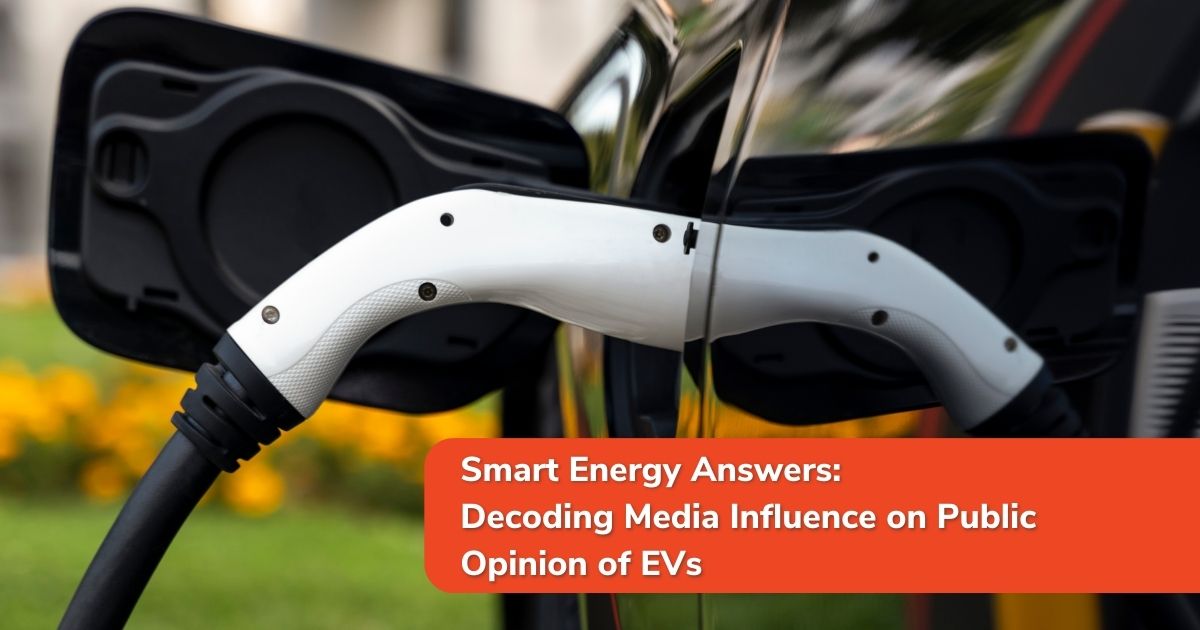Decoding Media Influence on Public Opinion of EVs

Uncover the impact of media on how the public views electric vehicles and explore ways to navigate through biased narratives.
Overview of the guide's focus on decoding media influence on EVs' public image
The guide aims to provide an in-depth analysis of how the media influences the public perception of electric vehicles (EVs). By decoding media coverage, readers will gain a better understanding of the factors that shape the image of EVs in the minds of the public.
Through this guide, readers will discover the power of the media in shaping public opinion and the importance of critically engaging with EV coverage. By examining various media outlets, including news, social media, and advertisements, readers will gain insights into how EVs are portrayed in these platforms.
Furthermore, the guide will explore the influence of balanced or biased coverage on public perception of EVs. It will delve into the ways in which stakeholders such as automakers, environmental organizations, and policymakers shape the narrative around EVs.
The guide will also assess public opinion trends and shifts in attitudes towards EVs over time. By understanding these trends, readers will be able to identify the factors that contribute to changing perceptions of EVs and the implications for EV adoption rates, policy decisions, and industry developments.
In addition, the guide will identify common misconceptions and myths propagated by media coverage of EVs. By debunking these misconceptions, readers will be able to navigate through biased narratives and form a more informed opinion about EVs.
Moreover, the guide will analyze online communities, influencers, and viral content related to EVs. It will examine the role of these platforms in shaping public perception and influencing attitudes towards EVs.
Finally, the guide will call for action for media professionals, stakeholders, and the public to critically engage with EV coverage. By encouraging active participation and critical thinking, readers will be empowered to question narratives and seek out reliable information about EVs.
Significance of media in shaping public perception and attitudes towards electric vehicles (EVs)
The media plays a significant role in shaping public perception and attitudes towards electric vehicles (EVs). Through various forms of media, such as news articles, social media posts, and advertisements, individuals are exposed to information and narratives that shape their understanding and opinion of EVs.
Media coverage can influence public perception by highlighting the benefits and drawbacks of EVs, showcasing success stories, or perpetuating misconceptions. The way EVs are portrayed in the media can impact their perceived reliability, affordability, and environmental impact, among other factors.
Moreover, the media has the power to shape public attitudes towards EVs by framing the narrative around these vehicles. Positive coverage can create a favorable perception and encourage adoption, while negative or biased coverage can generate skepticism and hinder adoption rates.
Given the media's significant influence, it is crucial to critically evaluate the information presented and consider the potential biases or agendas behind the narratives. By understanding the significance of media in shaping public perception, individuals can make more informed decisions about EVs and contribute to a more accurate and balanced understanding of these vehicles.
Analysis of how EVs are portrayed in different media outlets (e.g., news, social media, advertisements)
Different media outlets, including news sources, social media platforms, and advertisements, play a crucial role in shaping public perception of electric vehicles (EVs). Each outlet presents EVs in a unique way, influencing how they are perceived by the public.
News articles often provide detailed information about the latest developments in the EV industry, highlighting advancements in technology, government policies, and market trends. Social media platforms, on the other hand, offer a more interactive and personal approach, allowing users to share their own experiences and opinions about EVs.
Advertisements, both online and offline, contribute to the public image of EVs by showcasing their features, benefits, and environmental impact. They often aim to create a positive perception and generate interest in these vehicles.
Analyzing how EVs are portrayed in different media outlets is crucial to understanding the various narratives surrounding these vehicles. It allows individuals to recognize potential biases, misinformation, or misconceptions, and form a more comprehensive and informed opinion about EVs.
Influence of balanced or biased coverage on public perception of EVs
The balance or bias in media coverage of electric vehicles (EVs) has a significant influence on public perception. Balanced coverage presents a fair and objective view of EVs, providing information about both their advantages and limitations. This allows the public to make informed decisions based on a comprehensive understanding of the technology and its implications.
On the other hand, biased coverage can skew public perception by emphasizing certain aspects while downplaying or omitting others. Biased coverage may stem from various factors, including commercial interests, political agendas, or preconceived notions about EVs.
Biased coverage can lead to the propagation of misconceptions and myths about EVs, contributing to skepticism and hindering adoption rates. It is essential for the public to critically evaluate the balance or bias in media coverage and seek out reliable sources to ensure they are well-informed about EVs.
By recognizing the influence of balanced or biased coverage, individuals can avoid falling prey to misinformation and form their opinions based on accurate and trustworthy information.
Analysis of how stakeholders such as automakers, environmental organizations, and policymakers influence EV coverage
Stakeholders such as automakers, environmental organizations, and policymakers play a significant role in influencing the coverage of electric vehicles (EVs) in the media. These stakeholders have their own interests and agendas, which can shape the narratives surrounding EVs.
Automakers, for instance, may promote their EV models through advertisements and press releases, highlighting the features and benefits of their vehicles. Environmental organizations often advocate for EV adoption as a means to reduce carbon emissions and combat climate change, shaping the narrative around the environmental impact of EVs.
Policymakers also have a significant influence on EV coverage through the development of regulations, incentives, and infrastructure support. Their decisions and actions can impact the public perception of EVs by creating a supportive environment for their adoption.
Analyzing how these stakeholders influence EV coverage provides insights into the motives and narratives behind media portrayals. It allows individuals to critically evaluate the information presented and consider the potential biases or interests involved.
Assessment of public opinion trends and shifts in attitudes towards EVs over time
Assessing public opinion trends and shifts in attitudes towards electric vehicles (EVs) over time is crucial to understanding the evolving perception of these vehicles. Public opinion can be influenced by various factors, including media coverage, technological advancements, and environmental concerns.
By analyzing surveys, polls, and studies conducted over time, it becomes clear that attitudes towards EVs have undergone significant changes. Initially met with skepticism and concerns about range anxiety and charging infrastructure, EVs are now increasingly seen as a viable and sustainable transportation option.
Public opinion trends reveal a growing acceptance and interest in EVs, driven by factors such as increased environmental awareness, improvements in EV technology, and government incentives. Understanding these trends allows policymakers, industry stakeholders, and the public to adapt and respond to the changing attitudes towards EVs.
Moreover, assessing public opinion trends can help identify areas where further education and awareness campaigns are needed to address misconceptions or barriers to EV adoption.
Implications of public perception for EV adoption rates, policy decisions, and industry developments
Public perception of electric vehicles (EVs) has significant implications for EV adoption rates, policy decisions, and industry developments. The way EVs are perceived by the public can influence their willingness to adopt these vehicles and the rate at which they are adopted.
Positive public perception can accelerate EV adoption rates by generating interest, increasing consumer confidence, and creating a supportive environment. On the other hand, negative or skeptical public perception can hinder adoption rates by creating barriers and resistance to change.
Policy decisions regarding EV incentives, charging infrastructure, and emissions regulations are often influenced by public perception. Government support and initiatives are crucial in driving EV adoption, and public opinion plays a role in shaping these policies.
The automotive industry and other related sectors also respond to public perception by investing in EV research, development, and production. Positive public perception can drive industry developments and innovations, while negative perception may lead to stagnation or limited investment.
Understanding the implications of public perception for EV adoption rates, policy decisions, and industry developments is essential for policymakers, industry stakeholders, and the public to work collectively towards a sustainable transportation future.
Identification of common misconceptions and myths propagated by media coverage of EVs
Media coverage of electric vehicles (EVs) often propagates common misconceptions and myths that can mislead the public and hinder their understanding of these vehicles. Identifying and debunking these misconceptions is crucial for individuals to form a more accurate perception of EVs.
Some common misconceptions include concerns about limited range and charging infrastructure, high upfront costs, and the environmental impact of EV production. These misconceptions often stem from outdated information, biased narratives, or a lack of awareness about recent advancements in EV technology.
By addressing these misconceptions, individuals can navigate through biased narratives and make more informed decisions about EVs. It is important for the media and other stakeholders to actively challenge and correct these misconceptions to ensure the public has access to accurate and reliable information about EVs.
Through this guide, readers will gain the tools to identify and debunk common misconceptions and myths, enabling them to make informed choices about EVs and contribute to a more accurate public understanding of these vehicles.
Analysis of online communities, influencers, and viral content related to EVs
Online communities, influencers, and viral content have a significant impact on shaping public perception and attitudes towards electric vehicles (EVs). These platforms provide a space for individuals to share their experiences, opinions, and knowledge about EVs, influencing others in the process.
Online communities dedicated to EVs create a supportive environment for enthusiasts, allowing them to connect, exchange information, and address common concerns. Influencers, who have a large following and credibility in the EV space, can sway public opinion through their content and recommendations.
Viral content related to EVs, such as videos or articles that garner widespread attention and engagement, can shape the narrative around these vehicles and generate public interest or skepticism.
Analyzing online communities, influencers, and viral content provides insights into the dynamics of public opinion formation and the role of social media in shaping perceptions of EVs. It allows individuals to recognize the influence of these platforms and critically evaluate the information presented.
Moreover, understanding online communities, influencers, and viral content can help stakeholders in the EV industry and policymakers engage with these platforms effectively and leverage their potential to drive positive changes in public perception and adoption rates.
Call to action for media professionals, stakeholders, and the public to critically engage with EV coverage
A call to action is necessary for media professionals, stakeholders, and the public to critically engage with the coverage of electric vehicles (EVs). By actively questioning narratives, seeking out reliable information, and promoting balanced and accurate reporting, these individuals can contribute to a more informed and unbiased understanding of EVs.
Media professionals have a responsibility to provide balanced coverage, fact-check information, and avoid sensationalism or bias. By adhering to journalistic ethics and promoting accurate reporting, they can help shape a more accurate public perception of EVs.
Stakeholders, such as automakers, environmental organizations, and policymakers, should engage in transparent and informative communication about EVs. By providing accurate information and addressing misconceptions, they can contribute to a more informed public discourse and support EV adoption.
The public also has a role in critically engaging with EV coverage. By questioning narratives, seeking multiple sources of information, and actively participating in discussions, individuals can form a more comprehensive and accurate understanding of EVs.
Collectively, media professionals, stakeholders, and the public can work towards a more informed and unbiased coverage of EVs, enabling individuals to make informed decisions and contribute to a sustainable transportation future.
%20(1).png?width=265&height=96&name=www.smartenergyanswers.com.auhs-fshubfsSmart%20Energy%20Answers%20Logo%20(HIRES)%20(1).png)

.png?width=514&height=121&name=Tesla%20Powerwall%203%20(new).png)








.webp?width=300&height=180&name=sigenergy-gold-installer-300x180%20(1).webp)